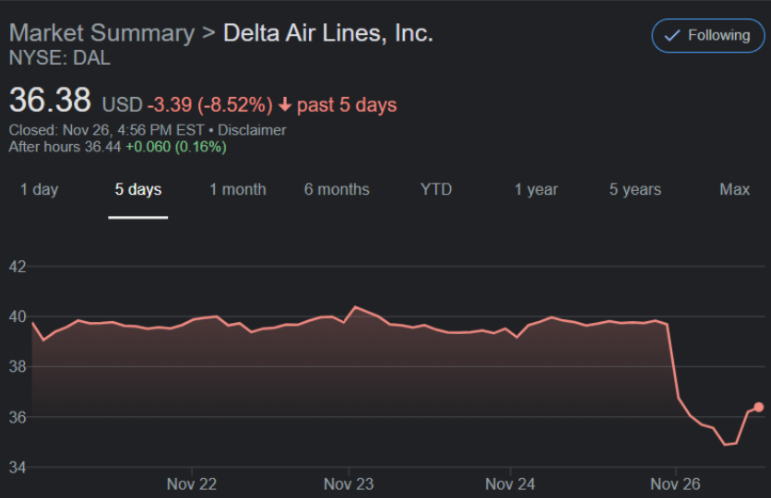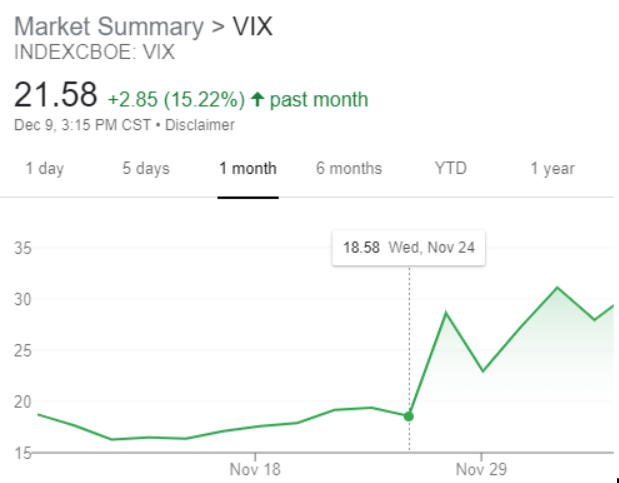The Omicron Variant and Crazy Investors
By Neil Tamhankar
Since the beginning of the pandemic and the wave of lockdowns during March 2020, the economy has made massive progress in recovering from rock bottom. Unemployment is down, stimulus payments are putting a lot of money into people’s pockets, and the U.S GDP for 2021 is predicted to be even higher than 2019, signaling healthy economic growth (I am only mentioning 2019 because the GDP for 2020 was lower than 2019 for obvious reasons). However, markets just saw their worst drop this year. Why have markets been so dismal this past week?
The answer is simple: fear. And the Omicron variant. But mostly fear. The crash of 2020 and the economic horrors that followed have been firmly imprinted in investors’ brains, and they will not soon forget. So when they heard of a newer, possibly more potent variant, they reasonably panicked and feared economic downturns as they anticipated history repeating itself.
The numbers: since Wednesday 11/24 (when Omicron was first detected), the S&P 500 has dropped 163 points, and the Dow Jones has fallen 1,124 points!


If Omicron truly is stronger than the Delta variant, and can potentially cause lockdowns the likes of which we haven’t seen since last year, what kind of economic impact are we looking at? First off, a multitude of businesses will shut down. With people being scared to go outside again, small companies will undoubtedly lose revenue and shutter their windows. The retail, transportation, and travel industries, among others, will be hit very hard as they lose customers by the millions. Unemployment will skyrocket as businesses close or aren’t raking in enough revenue to pay salaries. Seeing all these scary things, it’s easy to understand investors’ panic.
How is Omicron any different from Delta and other variants? Scientists believe that Omicron may be more contagious. However, the symptoms are “extremely mild,” according to the South African doctor who first discovered the variant. But the fear has spread quickly, and investor sentiment has plummeted. Investor sentiment is the overall attitude of investors towards the market, and right now, that attitude is pretty negative. Investor sentiment controls the market, so fear spreading like wildfire throughout the investing community is unfortunate. What can cause investor sentiment to rise again? Assurances. Assurances from vaccine makers that their vaccines are effective against Omicron. Assurances from scientists that Omicron itself isn’t very severe. Guarantees from the government that there will not be total lockdowns once again. If we get those assurances and Omicron ends up being a false alarm, we can expect a rapid market recovery to correct the current imbalance. The markets may even rise beyond what they were before the Omicron crash as investors ride a wave of relief that the economy won’t shut down.
What should you do? As always, there is an opportunity for you to make money. Prices are meager right now, and we can almost guarantee a market recovery soon. I would invest in index funds and ETFs. The S&P and the Dow Jones are sure to make a roaring comeback, and there’s no reason not to get in on the action. Another way to play this is by investing in sentiment. There are sentiment indices that track how investors feel about the market. One of the most popular sentiment indexes is VIX, also known as the fear index, because it spikes when investor sentiment is fearful. As you can see, it shot up on the day Omicron was discovered.
To recap: markets are down right now because of fear caused by the Omicron variant. Hopefully, within the next few weeks, that fear will be assuaged. Once people remember that there is nothing to fear but fear itself, markets are nearly guaranteed to shoot for the stars.
Bonus Round! Let’s analyze some shapes that we saw during Omicron.





